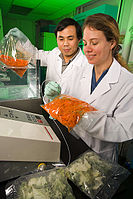
An exploratory analysis of poly- and per-fluoroalkyl substances in pet food packaging from the United States
Sign Up to like & getrecommendations! Published in 2020 at "Environmental Technology and Innovation"
DOI: 10.1016/j.eti.2020.101247
Abstract: Abstract Poly- and per-fluoroalkyl substances (PFAS) were reported to be used in food packaging to impart water and oil repellency. Little is known, however, with regard to the occurrence of PFAS in pet food packaging.… read more here.
Keywords: food packaging; per fluoroalkyl; poly per; pet food ... See more keywords

Environmental benefits of pet food obtained as a result of the valorisation of meat fraction derived from packaged food waste.
Sign Up to like & getrecommendations! Published in 2021 at "Waste management"
DOI: 10.1016/j.wasman.2021.02.035
Abstract: The 2030 Agenda of the United Nations includes the objective of setting up sustainable production patterns by pursuing several Sustainable Development Goals. Among them, the "Responsible production and consumption" is a key topic in the… read more here.
Keywords: production; packaged food; waste; pet food ... See more keywords

Effects of select copper sources at minimum supplementation levels on nutrient content, off-colors, and blemishes in canned pet food
Sign Up to like & getrecommendations! Published in 2022 at "Translational Animal Science"
DOI: 10.1093/tas/txac036
Abstract: Abstract In the previous research, super-fortification with copper decreased vitamin E content and darkened canned pet food, which prevented the analysis of black blemishes reported in commercial products. The pet food industry has linked these… read more here.
Keywords: copper; food; pet food; copper sources ... See more keywords

Whole genome sequencing confirms source of pathogens associated with bacterial foodborne illness in pets fed raw pet food
Sign Up to like & getrecommendations! Published in 2019 at "Journal of Veterinary Diagnostic Investigation"
DOI: 10.1177/1040638718823046
Abstract: Reports of raw meat pet food containing zoonotic foodborne bacteria, including Salmonella, Escherichia coli, and Listeria monocytogenes, are increasing. Contaminated raw pet food and biological waste from pets consuming those diets may pose a public… read more here.
Keywords: raw pet; food; whole genome; pet food ... See more keywords

Grains on the brain: A survey of dog owner purchasing habits related to grain-free dry dog foods
Sign Up to like & getrecommendations! Published in 2021 at "PLoS ONE"
DOI: 10.1371/journal.pone.0250806
Abstract: Grain-free pet food options abound in the pet food market today, representing more than 40% of available dry dog foods in the United States. There is currently a dearth of information about the factors that… read more here.
Keywords: dry dog; grain free; survey; pet food ... See more keywords

In vitro digestion and microbial fermentation of dried food residues, a potential “new” component for pet food, and different non-digestible carbohydrate sources
Sign Up to like & getrecommendations! Published in 2022 at "PLoS ONE"
DOI: 10.1371/journal.pone.0262536
Abstract: Food residues are often fed to dogs in private households and might also be a potential “new” ingredient for pet food in the future. As food residues might contain not only digestible, but also fermentable… read more here.
Keywords: potential new; food; food residues; non ... See more keywords

Investigating the market for cultivated meat as pet food: A survey analysis
Sign Up to like & getrecommendations! Published in 2022 at "PLOS ONE"
DOI: 10.1371/journal.pone.0275009
Abstract: The number of people reducing their meat consumption due to ethical and environmental concerns is growing. However, meat reducers sometimes care for omnivorous or carnivorous pets, creating the ‘vegetarian’s dilemma’. Some meat-reducers opt to feed… read more here.
Keywords: pet food; cultivated meat; meat pet; meat ... See more keywords

Effects of liquid smoke preparations on shelf life and growth of wild type mold and Aspergillus flavus in a model semi moist pet food
Sign Up to like & getrecommendations! Published in 2023 at "Frontiers in Microbiology"
DOI: 10.3389/fmicb.2023.1154765
Abstract: Liquid smoke is a naturally derived flavor component and preservative with known antimicrobial properties. To our knowledge, there is a paucity of information on antifungal potential of liquid smoke against toxigenic fungi like Aspergillus flavus… read more here.
Keywords: growth; pet food; moist pet; liquid smoke ... See more keywords

Case Report: A Case Series Linked to Vitamin D Excess in Pet Food: Cholecalciferol (Vitamin D3) Toxicity Observed in Five Cats
Sign Up to like & getrecommendations! Published in 2021 at "Frontiers in Veterinary Science"
DOI: 10.3389/fvets.2021.707741
Abstract: Cholecalciferol (vitamin D3) toxicity caused by defective pet food formulations is a rare occurrence described in cats. Nevertheless, it poses a health risk, even though the affected pet food is not fed as the sole… read more here.
Keywords: case series; pet food; case; vitamin toxicity ... See more keywords

Consumer attitudes toward bacteriophage applications to pet food
Sign Up to like & getrecommendations! Published in 2022 at "Frontiers in Veterinary Science"
DOI: 10.3389/fvets.2022.921508
Abstract: This study used a two-part questionnaire to investigate consumer knowledge and attitudes toward bacteriophage applications in pet food, pet food safety, and environmental sustainability. Part 1 included questions about pet food safety, sustainability, and knowledge… read more here.
Keywords: attitudes toward; food; pet food; toward bacteriophage ... See more keywords

Deep Learning-Based Quantitative Assessment of Melamine and Cyanuric Acid in Pet Food Using Fourier Transform Infrared Spectroscopy
Sign Up to like & getrecommendations! Published in 2023 at "Sensors"
DOI: 10.3390/s23115020
Abstract: Melamine and its derivative, cyanuric acid, are occasionally added to pet meals because of their nitrogen-rich qualities, leading to the development of several health-related issues. A nondestructive sensing technique that offers effective detection must be… read more here.
Keywords: pet food; spectroscopy; cyanuric acid; melamine cyanuric ... See more keywords